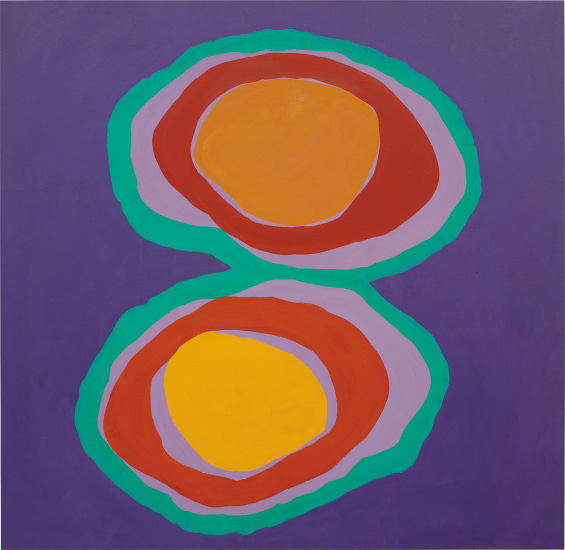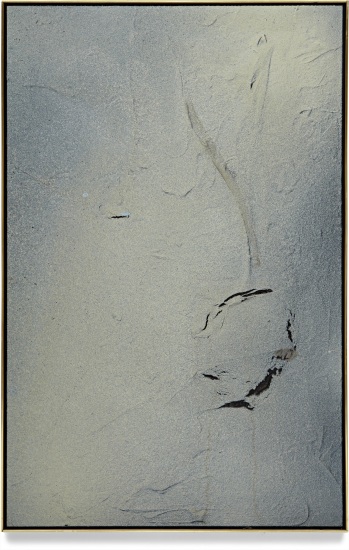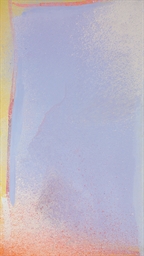Jules Olitski Basium Blush 1960 Magna on canvas 79 x 109 in. (200.7 x 276.9 cm) Initialed "J.O." on the reverse; further dated "1960" along the overlap.
Provenance The Jules Olitski Family Estate Yares Art Projects, Santa Fe Private Collection, Florida Exhibited Santa Fe, New Mexico, Yares Art Projects, Jules Olitski Radiance + Reflection, Stain Paintings & Drawings 1960 - 1964, July 5 - August 24, 2013 Literature Jules Olitski Radiance + Reflection, Stain Paintings & Drawings 1960 - 1964, exh. cat., Yares Art Projects, Santa Fe, New Mexico, p. 13 (illustrated) Catalogue Essay “Color in color is felt as any and every place of the pictorial organization; in its immediacy—its particularity. Color must be felt throughout.” Jules Olitski In Basium Blush, 1960, Jules Olitski articulates vibrant regions of color in the bold spirit of jazz improvisation. The artist created the work—the title of which includes the Latin word for “kiss”—following the emergence of post-war Abstract Expressionism in the United States. Like his contemporaries Helen Frankenthaler and Kenneth Noland Jules Olitski contributed significantly to the Color Field movement, dubbed “Post-Painterly Abstraction” by distinguished critic Clement Greenberg. Greenberg, who organized an exhibition of the same name with James Elliott in 1964, even hailed Olitski as the “best painter alive.” The artist and critic first met after Greenberg had signed a then-empty guestbook page for the young artist’s 1958 exhibition of French-inspired impasto paintings at Alexander Iolas Gallery, a meeting that would help ignite the artist’s career. Though strongly associated with the Color Field artists, who regarded figure and ground as a unified entity, Olitski restricted himself to neither a singular motif nor approach to art-making. He experimented widely with a mixture of new paints entering the market using quotidian tools such as sponges, mops, mitts, brooms, and rollers. The present lot is executed in Magna, an acrylic resin developed by Leonard Bocour in the late 1940s. Artists such as Roy Lichtenstein and Morris Louis preferred using this luminous medium, which was soluble in turpentine and mineral spirits (rather than water). It differed from the acrylic paint in use today by enabling artists to achieve a glossier, more “commercial” finish. Despite his expansive approach to material and sensitive treatment of surface in two versus three dimensions, Olitski remained devoted to abstraction in his paintings and sculptures. Educated in New York and Paris, he arrived at Bennington College as a painting instructor in 1963. His remarkable six-decade career—evidenced by over 150 solo exhibitions around the world—can be roughly divided into five periods: Stain, Spray, Baroque, High Baroque, and Late Paintings. Stain, in which the present lot belongs, marks a period of surface and medium coalescing. Having the appearance of a microscope view of cells or organisms, this work assertively projects color beyond the given surface. Utilizing Magna enabled Olitski to erase traces of gesture and obtain flat, unadulterated color, both in the optical and tactile sense. Here he conveys a composition rooted to the center by a large, forest-green shape and a pair of black-trimmed, red ovals, all of which are encapsulated in tangerine. At the same time, he pitches color outwardly with a limitless field of red, resulting in a contradictory combination of vastness and limitation. Two of Olitski’s works from 1962, Cleopatra Flesh and Cadmium Orange of Dr. Frankenstein, exemplify how the artist simultaneously evoked feelings of boundlessness and control—along with a pure experience of color—in more ways than one. As in Basium Blush, the paint seems to spread past the canvas support, but stains of organic shapes resolutely pull the composition back in. It is in striking works like these that the viewer can observe simplicity of color and form, movement and stillness. Soon after in 1965, Olitski started applying paint with a spray gun in order to heighten the intensity of color. The non-linear results suggest an exemption from gravity’s pull, with colors e
Jules Olitski Basium Blush 1960 Magna on canvas 79 x 109 in. (200.7 x 276.9 cm) Initialed "J.O." on the reverse; further dated "1960" along the overlap.
Provenance The Jules Olitski Family Estate Yares Art Projects, Santa Fe Private Collection, Florida Exhibited Santa Fe, New Mexico, Yares Art Projects, Jules Olitski Radiance + Reflection, Stain Paintings & Drawings 1960 - 1964, July 5 - August 24, 2013 Literature Jules Olitski Radiance + Reflection, Stain Paintings & Drawings 1960 - 1964, exh. cat., Yares Art Projects, Santa Fe, New Mexico, p. 13 (illustrated) Catalogue Essay “Color in color is felt as any and every place of the pictorial organization; in its immediacy—its particularity. Color must be felt throughout.” Jules Olitski In Basium Blush, 1960, Jules Olitski articulates vibrant regions of color in the bold spirit of jazz improvisation. The artist created the work—the title of which includes the Latin word for “kiss”—following the emergence of post-war Abstract Expressionism in the United States. Like his contemporaries Helen Frankenthaler and Kenneth Noland Jules Olitski contributed significantly to the Color Field movement, dubbed “Post-Painterly Abstraction” by distinguished critic Clement Greenberg. Greenberg, who organized an exhibition of the same name with James Elliott in 1964, even hailed Olitski as the “best painter alive.” The artist and critic first met after Greenberg had signed a then-empty guestbook page for the young artist’s 1958 exhibition of French-inspired impasto paintings at Alexander Iolas Gallery, a meeting that would help ignite the artist’s career. Though strongly associated with the Color Field artists, who regarded figure and ground as a unified entity, Olitski restricted himself to neither a singular motif nor approach to art-making. He experimented widely with a mixture of new paints entering the market using quotidian tools such as sponges, mops, mitts, brooms, and rollers. The present lot is executed in Magna, an acrylic resin developed by Leonard Bocour in the late 1940s. Artists such as Roy Lichtenstein and Morris Louis preferred using this luminous medium, which was soluble in turpentine and mineral spirits (rather than water). It differed from the acrylic paint in use today by enabling artists to achieve a glossier, more “commercial” finish. Despite his expansive approach to material and sensitive treatment of surface in two versus three dimensions, Olitski remained devoted to abstraction in his paintings and sculptures. Educated in New York and Paris, he arrived at Bennington College as a painting instructor in 1963. His remarkable six-decade career—evidenced by over 150 solo exhibitions around the world—can be roughly divided into five periods: Stain, Spray, Baroque, High Baroque, and Late Paintings. Stain, in which the present lot belongs, marks a period of surface and medium coalescing. Having the appearance of a microscope view of cells or organisms, this work assertively projects color beyond the given surface. Utilizing Magna enabled Olitski to erase traces of gesture and obtain flat, unadulterated color, both in the optical and tactile sense. Here he conveys a composition rooted to the center by a large, forest-green shape and a pair of black-trimmed, red ovals, all of which are encapsulated in tangerine. At the same time, he pitches color outwardly with a limitless field of red, resulting in a contradictory combination of vastness and limitation. Two of Olitski’s works from 1962, Cleopatra Flesh and Cadmium Orange of Dr. Frankenstein, exemplify how the artist simultaneously evoked feelings of boundlessness and control—along with a pure experience of color—in more ways than one. As in Basium Blush, the paint seems to spread past the canvas support, but stains of organic shapes resolutely pull the composition back in. It is in striking works like these that the viewer can observe simplicity of color and form, movement and stillness. Soon after in 1965, Olitski started applying paint with a spray gun in order to heighten the intensity of color. The non-linear results suggest an exemption from gravity’s pull, with colors e



.jpg)
.jpg)



.jpg)

.jpg)




Try LotSearch and its premium features for 7 days - without any costs!
Be notified automatically about new items in upcoming auctions.
Create an alert